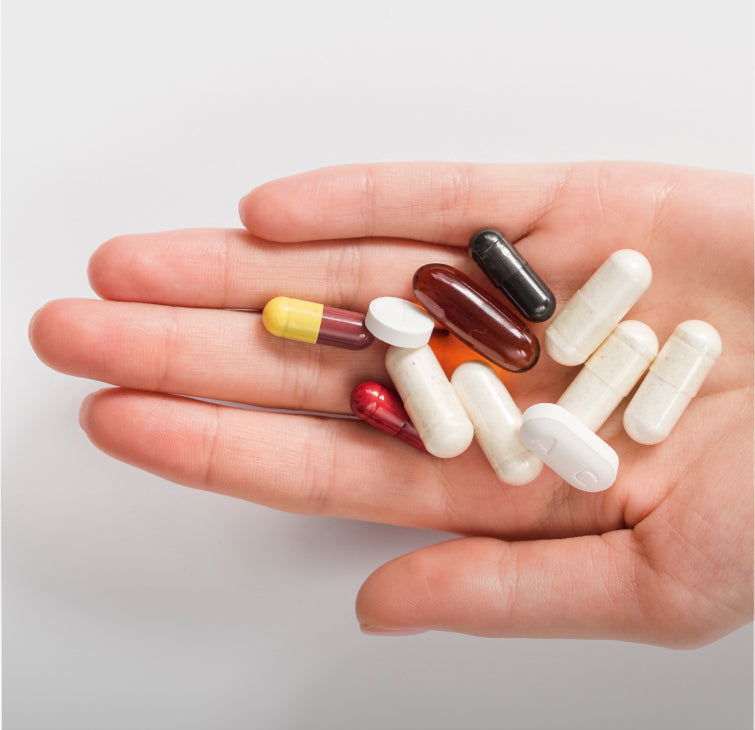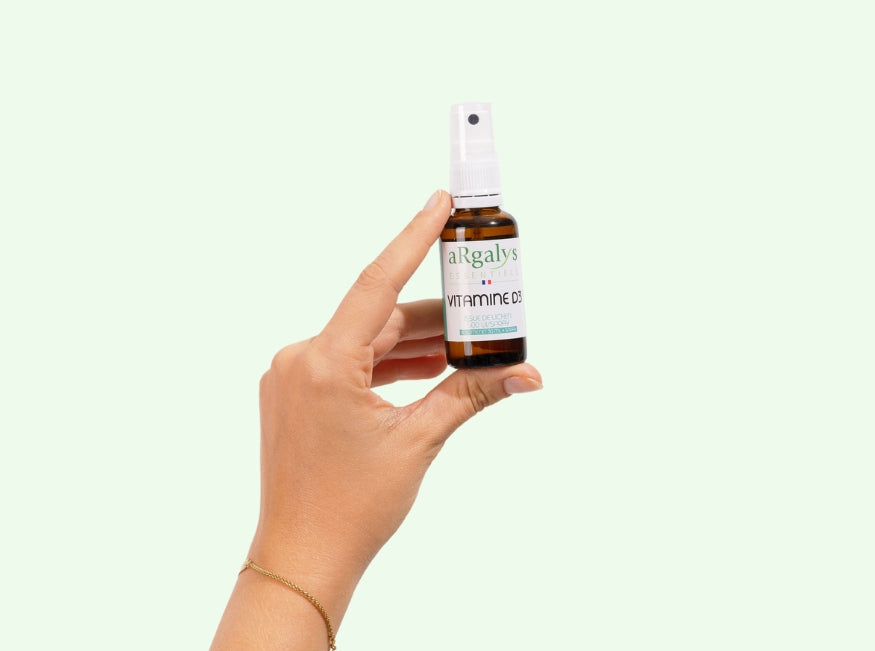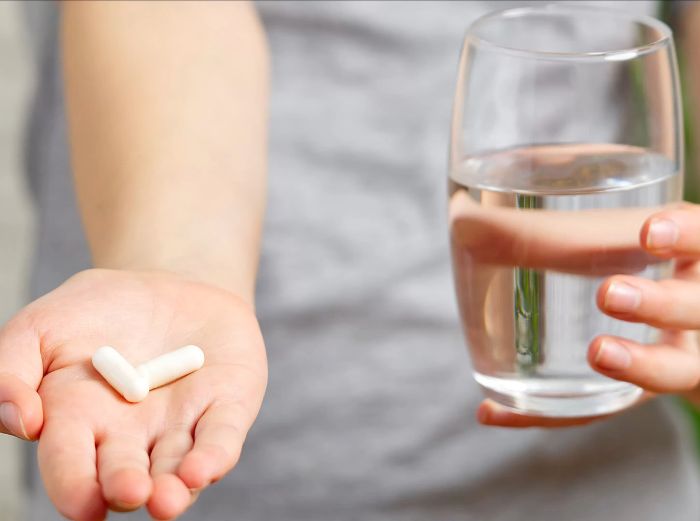Vitamin D is essential for early health. Wondering if you can get enough of it daily ? This article provides an overview of the benefits of vitamin D , daily requirements, deficiency risks, and options for optimizing your intake.
The role of Vitamin D in the body
Vitamin D is essential for the body. It is involved in the fixation of calcium and phosphorus, two essential minerals for the strength of bones and teeth . This explains its fundamental importance in children from the first days until the end of their growth . Rickets is the result of a prolonged vitamin D deficiency. In adults and seniors, it helps prevent bone fragility and osteoporosis [1].
Vitamin D also acts on the immune system by strengthening natural defenses and helping to reduce inflammation. Studies have shown its positive impact on mood and mental health, influencing neurotransmitters in the brain [2]. Vitamin D is not water-soluble (it is fat-soluble), which explains its low renal elimination and its possible storage in the body's fatty tissues.
What are the vitamin D requirements?
Daily physiological requirements for vitamin D are almost constant throughout life.
Expressed in kg of body weight, the needs are therefore much greater in growing children.
For adults, desirable daily intakes are between 500 and 1000 IU (international units), although higher doses up to 1000-2000 IU may be necessary in cases of reduced sun exposure or increased risk of deficiency [3].
Children, from birth, have particularly high needs for vitamin D. Recommended intakes range from 400 IU per day for infants to 800 IU for children and adolescents [4]. During growth, vitamin D is essential for bone development and the prevention of diseases such as rickets.
How to identify a vitamin D deficiency?
Vitamin D deficiency manifests itself through a variety of non-specific symptoms. Here are the signs to watch for:
- Fatigue and muscle weakness: A lack of vitamin D can lead to general fatigue and muscle pain.
- Bone and joint pain: Because vitamin D is crucial for bone health, a deficiency can cause pain in the bones and joints.
- Susceptibility to infections: Vitamin D supports the immune system, and a deficiency can make you more susceptible to colds, flu, and other infections.
- Mood disorders: Research shows that vitamin D deficiency can affect mood and contribute to depression [5].
In children, vitamin D deficiency increases the fragility and bone deformities typical of rickets and causes growth retardation. Vitamin D supplementation from the first month after birth is now routine in pediatric care, but adequate intake must also be ensured throughout growth.
How to get your daily vitamin D intake
Vitamin D can be obtained in a variety of ways. A combination of diet, sun exposure, and supplements can often help maintain adequate intake .
Foods rich in vitamin D
The richest dietary sources of vitamin D3 are animal-based . Oily fish, such as salmon, mackerel, and sardines, contain high amounts, but their consumption should ideally be limited to twice a week due to heavy metals linked to marine pollution. Other sources include egg yolks, organ meats, and some vitamin D- fortified dairy products.
On the plant side, some foods such as mushrooms and avocados provide vitamin D, but in the form of D2 , which is less well absorbed by the body. However, food alone is rarely enough to cover daily vitamin D requirements [6]. Historically, cod liver oil was commonly given to children to compensate for this deficiency.
Sun exposure produces vitamin D
Exposure to sunlight allows the body to produce its own vitamin D3 .
In summer, 30 minutes of exposure per day, with arms and legs uncovered, is generally sufficient to meet vitamin D needs. However, the use of sunscreen, necessary to prevent UV risks, limits vitamin D production. Darker skin, on the other hand, produces less vitamin D under the same radiation.
In autumn and winter, sun exposure is insufficient to cover vitamin D needs . Thus, although valuable, sun exposure remains a variable and occasional source of vitamin D , often insufficient over the year to maintain a good level.
Vitamin D medications
Vitamin D can be administered as a high-dose injection, which can cover needs for several months (3 to 6 months) thanks to its storage in fatty tissue. This type of supplementation should only be considered under strict medical supervision, as such a high single dose presents potential risks. It is therefore essential to discuss this option with a healthcare professional to assess the benefits and precautions to be taken.
Vitamin D3 food supplements
Alternatively, vitamin D supplements are an effective solution with moderate intake.
Regular daily intakes of 400 to 800 IU already provide significant safety. Some studies indicate that supplementation of 1000 to 2000 IU per day is more suitable for achieving optimal levels, especially during the winter months [7].
For children, the French Pediatric Society recommends an intake of 400 IU from the first month, with a tolerance of up to 800 IU. Vitamin D administration in young children should be done in consultation with the pediatrician.
Can I take vitamin D every day?
Moderate daily supplementation, between 400 and 800 IU , is a simple and effective method to ensure the body has a sufficient intake of vitamin D3 , at all ages, from a very young age.
Indeed, dietary intake of vitamin D is generally insufficient to cover daily needs, and sun exposure, although it promotes the synthesis of this vitamin, remains a point source, often limited to adults and the summer months.
Furthermore, although vitamin D is stored in fatty tissue, the use of massive injectable doses is reserved for medical purposes and is only used in specific cases.
Vitamin D2 or D3, which should you take daily?
Vitamin D exists in two molecular forms:vitamin D2 (ergocalciferol) and vitamin D3 (cholecalciferol). Vitamin D3 is the form our bodies naturally produce when exposed to sunlight, while vitamin D2 is of plant origin. It is found in certain sources, such as certain mushrooms.
Although both forms have similar effects, functionally, vitamin D3 is more effective than vitamin D2 because it is better stored and more available [3].
For those following a strict vegan or vegetarian diet, plant-based vitamin D3 options are available, including Arctic lichen extract, a natural and sustainable source of vitamin D3 suitable for animal-free diets. At Argalys, this is the option we have chosen for our vitamin D3 supplement.
Is there a risk of vitamin D overdose?
In adults, excess vitamin D is rare , but it can occur in cases of excessive consumption of supplements beyond the recommended doses and injection of massive doses that are poorly tolerated.
Signs of excess include nausea, vomiting, loss of appetite, and abdominal pain [8].
The maximum recommended daily dose for adults is 4000 IU, while for children it varies depending on age (usually 1000 to 2000 IU maximum for younger children).
On the other hand, in children, and particularly the youngest such as infants, great vigilance is required to respect the safe daily dosages (400/800 IU).
The two essential precautions are the agreement of the pediatrician on the one hand and on the other hand, to ensure that it is always the same person who administers it to the child, to avoid any confusion.
Prolonged overdose of vitamin D can lead to a buildup of calcium in the blood, causing stones.
Conclusion
Vitamin D is essential for bone, immune and nerve health.
Although sun exposure and a proper diet provide some of the needs, supplementation is a safe strategy to maintain optimal levels in most situations.
This is why it is recommended to supplement with vitamin D every day, respecting reasonable dosages (400/800 to 1000 IU).
At Argalys, we have developed a plant-based vitamin D3 supplement in spray form to make it easier for adults and children to take and consume (500 IU per spray).
References:
- “Vitamin D and bone health” - https://pubmed.ncbi.nlm.nih.gov/30094137/
- “Vitamin D’s impact on mood and mental health” - https://pubmed.ncbi.nlm.nih.gov/22048573/
- "Dietary Reference Intakes for Calcium and Vitamin D" - https://pubmed.ncbi.nlm.nih.gov/21736837/
- “Vitamin D and childhood health” - https://pubmed.ncbi.nlm.nih.gov/28960101/
- "Nutritional sources of vitamin D" - https://pubmed.ncbi.nlm.nih.gov/27637696/
- “Vitamin D deficiency and fatigue in adults” - https://pubmed.ncbi.nlm.nih.gov/29693614/
- "The role of vitamin D supplementation in adults" - https://pubmed.ncbi.nlm.nih.gov/29529255/
- "Vitamin D toxicity and upper intake levels" - https://pubmed.ncbi.nlm.nih.gov/18593719/
 04 74 03 98 80
04 74 03 98 80










